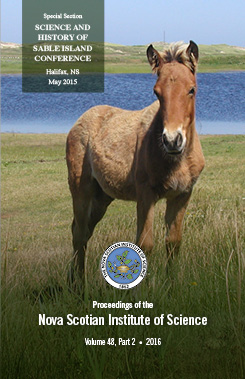History of the natural history of Sable Island
DOI:
https://doi.org/10.15273/pnsis.v48i2.6664Abstract
Documenting of natural history flourished with exploration of remote parts of North America during the late 18th and early 19th centuries, but the earliest published observations on the biota of Sable Island, along with casual observations in the journals of successive superintendents are vague, and emphasize exploitability. John Gilpin‘s 1854 and 1855 visits were the first by a knowledgeable naturalist. His published 1859 “lecture” includes sketchy descriptions of the flora, birds, pinnipeds, and a list of collected marine molluscs. Reflecting growth of ‘cabinet‘ natural history in New England, J. W. Maynard in 1868 collected a migrant sparrow in coastal Massachusetts, soon named Ipswich Sparrow and recognized as nesting on Sable Island. This persuaded New York naturalist Jonathan Dwight to visit the island in June-July1894 and produce a substantial monograph on the sparrow. He in turn encouraged Superintendent Bouteiller‘s family to send him many bird specimens, some very unusual, now in the American Museum of Natural History. Dominion Botanist John Macoun made the first extensive collection of the island‘s plants in 1899, but only wrote a casual account of the biota. He possibly also promoted the futile tree-planting experiment in May 1901 directed by William Saunders, whose son, W. E., published some observations on the island‘s birds, and further encouraged the Bouteillers to make and publish systematic bird observations, 1901-1907. This account closes with Harold St. John‘s 1913 stay on the island and his first truly modern treatment of the island‘s flora in 1921. Little more was added before modern biological research was initiated, arguably with censuses and biological sampling of seals in the early 1960s.


